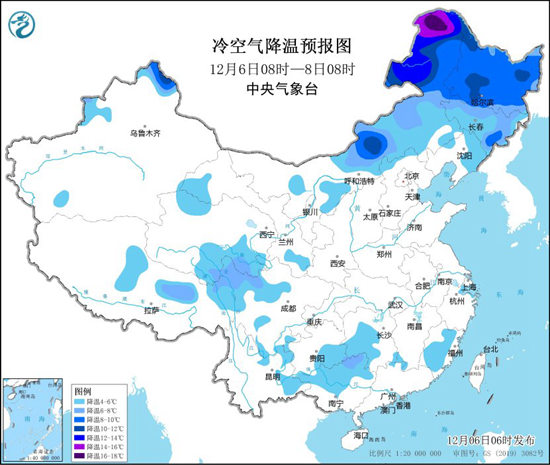Cctv newsAccording to China Weather Network, at present, most of northern China is experiencing a strong cold air activity, and this cold air will continue to move eastward today and tomorrow (December 6-7). Due to the overall influence of cold air to the east and north, the cooling time is short. Although the temperature in some areas such as northwest, north China and Huanghuai fluctuates, it will not completely reverse the current high temperature situation. In addition, in the next three days, most areas in China will still maintain the pattern of scarce precipitation.
Cold air actively "opens" the temperature in many places in the north is like riding a roller coaster.
Yesterday, a strong cold air appeared, affecting most parts of northern China from west to east. Monitoring shows that at 06: 00 today, compared with 06: 00 yesterday, the temperature in central and eastern Inner Mongolia, northwestern Shanxi, northwestern Hebei and northwestern Heilongjiang dropped by 4 ~ 8 C, and the local drop exceeded 10 C.
Today and tomorrow, this cold air will continue to move eastward. Inner Mongolia, Northeast China, northern Xinjiang and other places will have a temperature drop of 4 ~ 8 C. Among them, the temperature drop in eastern Inner Mongolia and Heilongjiang can reach 10 ~ 14 C, and the local temperature will exceed 14 C. In addition, during the day, there will be 4 ~ 5 winds in parts of Inner Mongolia, North China, Huanghuai and Northeast China, with gusts of 7~8. There will be sand or dusty weather in parts of western Inner Mongolia, eastern Gansu, Ningxia, north-central Shaanxi, most of Shanxi, southern Hebei, north-central Henan and western Shandong.

However, due to the overall influence of this cold air to the east and north, the cooling time is short. Although the temperature in some areas such as northwest, north China and Huanghuai fluctuates, it will not completely reverse the current high temperature situation. It is estimated that on the 8th, the highest temperature in Shijiazhuang will reach 21℃, in Jinan 20℃, in Zhengzhou 23℃ and in Hefei 23℃, and the warmth will be rare in the same period of the year.
Looking forward to the later period, there will be a cold air relay from the 8 th to the 9 th, and this cold air will go deeper south. By then, the temperature in Inner Mongolia, North China, Huanghuai and Northeast China will drop by 4 ~ 8℃ one after another, and the temperature drop in eastern Inner Mongolia and south-central Northeast China will reach more than 10℃.
In the next three days, most of China’s precipitation is scarce, and the development of rainfall in the south has increased since the 9 th
Compared with cooling, the rain and snow weather brought by cold air in the northern region is slightly inferior. Yesterday, only small to medium snow or sleet appeared in parts of northern Xinjiang, northwestern Heilongjiang and eastern Tibet.
In the next three days, most areas in China will still maintain the pattern of scarce precipitation. Among them, today and tomorrow, due to the influence of cold air, there will be small to medium snow or sleet in the northeastern part of Inner Mongolia, the northern and eastern parts of Northeast China, and the northern Xinjiang, and the local area will be as big as blizzard; The rainy weather in the south will increase again from the 9th.
Specifically, the Central Meteorological Observatory predicts that today, there will be small to medium snow or sleet in parts of northeastern Inner Mongolia, northwestern and eastern Heilongjiang, eastern Jilin, eastern Liaoning, northern and eastern Xinjiang, eastern Tibet, southern Sichuan Plateau and northwestern Yunnan, among which there will be heavy snowstorms in eastern Jilin and northern Xinjiang. There is light rain in parts of southern Sichuan, most of Yunnan, southeastern Guangxi, southern Guangdong, Hainan Island and Taiwan Province Island, among which there is moderate rain in the eastern part of Taiwan Province Island.

Tomorrow, there will be small to medium snow or sleet in parts of eastern Inner Mongolia, central and western Heilongjiang, northern Xinjiang, eastern Tibet, southern Sichuan Plateau and northwestern Yunnan. Among them, there will be heavy snowstorms in Ili Valley of Xinjiang and southeastern Tibet. There are small to moderate rains in parts of southern Tibet, southern Sichuan, central and western Yunnan and Taiwan Province Island, among which there is heavy rain in western Yunnan.

The day after tomorrow, there will be small to medium snow or sleet in parts of northeastern Inner Mongolia, most of Heilongjiang, central Jilin, northern Xinjiang, eastern Tibet and western Sichuan Plateau. Among them, there are heavy snowstorms in parts of northern Heilongjiang, Ili Valley in Xinjiang, eastern Tibet and southern western Sichuan Plateau. There are small to moderate rains in parts of southeastern Tibet, southern Sichuan Plateau, most of Yunnan, Sichuan Basin, northeastern Guizhou, Hunan, southern Hubei, north-central Jiangxi, western Zhejiang and southern Anhui, among which there is heavy rain in western Yunnan.

China Weather Network reminds that cold air activities will be frequent in the next few days, and the temperature will fluctuate rapidly. The public should pay attention to the latest forecast in time, appropriately increase or decrease clothes, and take personal protection when going out.
关于作者